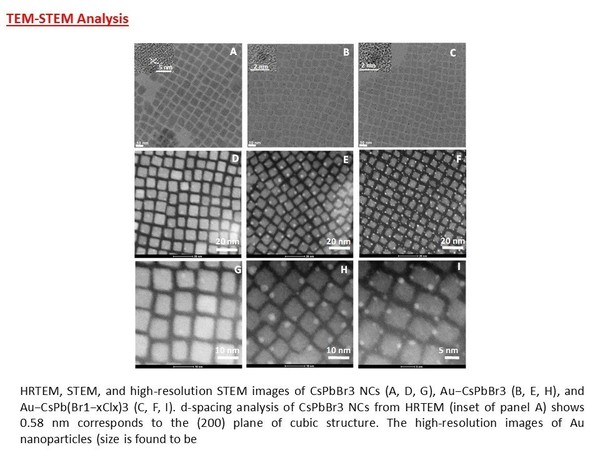
Au–CsPbBr3 Hybrid Architecture: Anchoring Gold Nanoparticles on Cubic Perovskite Nanocrystals
Subila K. Balakrishnan and Prashant V. Kamat, ACS Energy Letters, 2017, 2, pp 88–93. DOI : 10.1021/acsenergylett.6b00592T
The morphological characterization is very important when we design a new material and this paper is the first report on the synthesis of perovskite-metal hybrid nanomaterials.

TEM imaging along with STEM and TEM EDS analysis contributes extensively to characterize this new material. We thank Dr. Sergei Rouvimov of Notre Dame Integrated Imaging Facility Advanced Electron Microscopy Core for his excellent assistance in TEM and STEM measurements.

A selective growth of gold (Au) nanoparticles on the corners of CsPbBr3 nanocrystals (NCs) is made possible with the treatment of Au(III) salts such as Au(III) bromide and Au(III) chloride in solution. The TEM images show the formation of
Au nanoparticles on the corners of CsPbBr3 NCs. The scanning transmission electron microscopy (STEM) imaging of these samples and the z-scanning of the STEM imaging clearly differentiates the CsPbBr3 and Au lattice as facilitated by the difference in contrast based on the atomic mass. The STEM images confirm the formation of metal nanoparticles on the corners of perovskite NCs. It is interesting to note that Au nanoparticles were selectively formed on the lateral facets of perovskite NCs. Formation of Au nanoparticles as well as an anion exchange is seen when Au(III) bromide was replaced with Au(III) chloride as a precursor and this were confirmed from the TEM-EDS analysis. This simple strategy of designing perovskite−gold hybrid nanostructures with good colloidal stability offers new opportunities to explore their photocatalytic properties. We think that this is one of the publications where we used microscopic imaging technique to understand very well the new material formed and this work would not be possible to publish without any of these imaging techniques.

EDS analysis along with imaging provide in-depth details of this new materiel and we strongly believe that this is one of the good "imaging publication" happened recently from our research group.